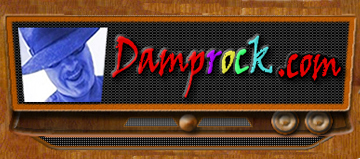 |
Colorado band named Climax - The Summer of 1967 - the move to Hollywood, CA.
|
| Morphing into the Electric Prune brand |
| 2012 Reissue of "The Complete Reprise Singles" from the Electric Prunes. |
|
How
musicians in a Colorado band named Climax
morphs into
The Electric Prunes..it
was 1967
|
Mark
Kincaid, Guitar
John Herron, Keyboards/Hammond B3
Bob Brandenburg, Bass & Vocals
Dick Whetstone, Drums & Vocals

Formed late in 1966, this Denver based group, a veteran line-up of musicians, blended blues, R&B, soul with
rock & roll. They could sound like a four piece Ray Charles
band and agilely shift to the heavy influenced Hammond B3 organ
sound, reminesent of Steve Winwood's Traffic, yet manage to
combine the powerfully dynamic sound presence of Vanilla Fudge.
The band quickly gained a dedicated
following and garnered the attention of industry names who would,
by the following summer, change forever the direction and legacy
of this group. |

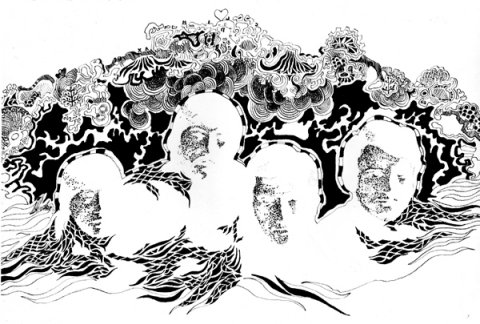 Mark
Kincaid - John Herron - Bob Brandenburg - Richard (Dick) Whetstone Mark
Kincaid - John Herron - Bob Brandenburg - Richard (Dick) Whetstone
Graphic
by John Herron '67
|
1967 - Climax moves to Hollywood
hired to morph into the Electric Prunes,
completing two remaining albums for Reprise/Warner Bros Records.
The Summer of 1967 - the move to Hollywood, CA.
The
Electric Prunes reincarnation -
When Electric Prunes
producer Dave Hassinger was looking for new musicians to take the
group's name, they were steered toward a Colorado band called Climax
by guitarist-singer Rich Fifield. Rich Fifield had been in a fellow
Colorado group the Astronauts, who'd had some success on RCA as
a surf act; by the late '60s, had now formed Hardwater,
who were also managed by Lenny Poncher (Manager of the Electric
Prunes, Traffic and Ten Years After), as well as being produced
by David Axelrod on Capitol Records.
"They called up
and said they needed some musicians to fulfill the contract [for]
the last two albums for Damo Productions, Dave Hassinger's production
company," recalls Richard Whetstone, the drummer in Climax
at the time. "They needed a band to fulfill the production
agreement." Joining Whetstone in the move to Los Angeles were
organist John Herron and guitarist Mark Kincaid, with bassist Brett
Wade recruited via the Collectors—the same Canadian band who
had played on Mass in F Minor, and who had also been produced by
Hassinger. Randy Meisner was actually offered the position first;
he turned it down, instead joining the original lineup of Poco,
and later of course becoming a star as part of the Eagles. Whetstone
confirms that although the band were given the choice of recording
under either the Electric Prunes billing or a different name, they
opted for the Electric Prunes moniker.
By the time
Release of an Oath was issued in 1968, no members were left from
the lineup that had recorded
|
Electric
Prunes 1967 -
Mark Kincaid, John Herron, Dick Whetstone,
Brett
Wade - Warner Bros/Reprise Records |
the 1967 smash hit "I Had Too
Much to Dream (Last Night)." The newly recruited group of musicians
— drummer/vocalist Richard Whetstone, organist John Herron
and guitarist Mark Kincaid, along with basist/guitarist Brett Wade
(associated with Canadian band the Collectors), were the keepers
of the flame. It was this lineup that began work on Just Good Old
Rock and Roll, the only Electric Prunes album to feature almost
exclusively original material, with Dave Hassinger remaining in
the producer's seat. Dave Hassinger, was famed as an engineer for
the Rolling Stones and Jefferson Airplane (and as a producer not
only of the Prunes, but also of the Grateful Dead's first LP).
Before the LP was finished, however, there would be one final change
of personnel, with Ron Morgan coming in on guitar and Herron leaving
the group (although his organ work is listed in the credits). Morgan
had a fair amount of experience in both the Colorado and Los Angeles
rock scenes, having been in the L.A. group Peter and the Wolves
(with a pre-Moby Grape Peter Lewis] and the Colorado group Superband;
he also played guitar, and wrote some material, on the f rst three
albums by the West Coast Pop Art Experimental Band, a legendarily
strange and erratic L.A. psychedelic outfit. Also in Superband was
keyboardist Jimmy Greenspoon. and both Morgan and Greenspoon would
be in an early version of Three Dog Night, though Morgan didn't
record with the latter band. According to an interview with Morgan's
brother, Bob Morgan, on the Electric Prunes Web Page, "Three
Dog Night bombed at two shows that I saw, one with Canned Heat and
one with Electric Flag. Ron was never happy with their direction,
and when [Three Dog Night singer Danny] Hutton gave Ron a contract
to sign, Ron brought it to Denver for a lawyer to look over. The
lawyer advised Ron not to sign it, since it didn't have any value
that benefited Ron's interests. By the time he got back to LA, the
band had replaced him.
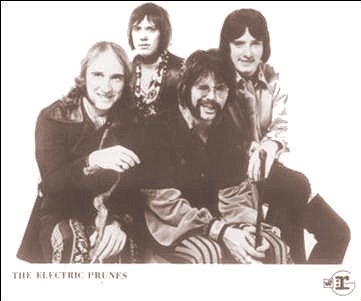
Electric
Prunes 1968 - Brett Wade, Mark Kincaid,
Ron Morgan, and Dick Whetstone
(Clayton Gromer would briefly replace Brett Wade on bass in 1969)
|
As to how Morgan
got involved with the Electric Prunes, Richard Whetstone explains,
"John Herron was playing keyboards, and contributed a significant
amount to the writing, arranging, and lyrics. We did a performance
in Las Vegas, and after that, John came back and said, 'I don't want
to do this any more.' We were about two-thirds through with Just Good
Old Rock and Roll, and we approached Ron to come in and finish recording
several tunes and to overdub additional guitar tracks and to add guitar
solos. As for Ron, you could wake him up in the middle of the night,
strap a guitar on him, and he could play a guitar solo. He was a world-class
player, a very, very good player. So we said, 'Okay, we'll bring in
Ron, and have him complete all the guitar tracks.' So he joined the
band, just after he'd quit Three Dog Night." With the
exception of "Finders Keepers, Losers Weepers" (cowritten
by Jimmy Holiday, co-author of Jackie DeShannon's 1969 smash "Put
a Little Love in Your Heart"), all of the material on Just Good
Old Rock and Roll (credited on the front cover to "the new improved
Electric Prunes") originated with the band, John Herron collaborating
with his sister and lyricist Mary Herron on "Sell" and "Tracks."
In addition to writing several of the Just Good Old Rock and Roll
songs, incidentally, Brett Wade also wrote "Flowing Smoothly,"
the B-side of the non-LP 1969 single "Hey Mr.President";
both tracks were included as bonus cuts on the CD reissue of Mass
in F Minor. "Dave Hassinger had a bright idea about recording
a topical, if not somewhat political song titled, 'Hey, Mr. President,"
discloses Whetstone. "Dave
|
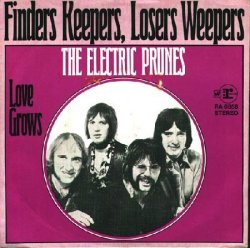
|
|
The
45 rpm single released in Europe bore this sleeve |
insisted that we
record it. The other song that Dave directed that we record was 'Finders
Keepers, Losers Weepers.' For the background vocals in 'Hey Mr. President,'
Brett and I sang falsetto into a microphone that was wired through
a spinning Hammond B3 Leslie speaker. It was released as a single,
which ironically received more circulation in Europe than the US.
Whetstone confirms that for Just Good Old Rock and Roll, the Electric
Prunes as they now existed were allowed to be their own band. The
record has a much more straightforward, funk-influenced hard rock
sound than any previous Electric Prunes long-players, though a few
songs, particularly the Wade-penned "So Many People to Tell"
and "Silver Passion Mine," had a more delicate late-psychedelic
feel. "That's Brett's influence," observes Whetstone. "He
came from a different, Canadian approach to songwriting. Although
he was playing bass, he was really a guitar player [who] came to us
through the well-known Canadian group, the Collectors."
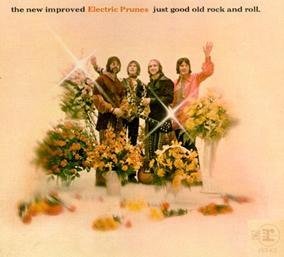 As
for the range of styles on Just Good 0/d Rock and Roll, Whetstone
remarks, "We were fairly naive in terms of guidance; we had
none, so we were experimenting with a lot of musical styles. If
you listen to the album, you'll hear a lot of diversity, feel and
tempo changes. One reviewer, at the time, said that it was reminiscent
of some of the Yardbirds' tunes. I thought, 'Well, what a nice compliment.'
But it was a little disjointed, and probably lacked a cohesive direction.
We were just throwing everything into the mix. I think once we had
that album completed, we should have started recording another album
with the remaining material we had available. That was our learning
curve." (The exact review quote Whetstone refers to above,
incidentally, was in a June 1969 issue of Boston After Dark, which
declared, "The tunes are driving and reminiscent in their abundant
tempo changes of the old Yardbirds...Every song has been lovingly
polished and yet the hard organ and basic guitar lines leave the
visceral immediacy intact.") As
for the range of styles on Just Good 0/d Rock and Roll, Whetstone
remarks, "We were fairly naive in terms of guidance; we had
none, so we were experimenting with a lot of musical styles. If
you listen to the album, you'll hear a lot of diversity, feel and
tempo changes. One reviewer, at the time, said that it was reminiscent
of some of the Yardbirds' tunes. I thought, 'Well, what a nice compliment.'
But it was a little disjointed, and probably lacked a cohesive direction.
We were just throwing everything into the mix. I think once we had
that album completed, we should have started recording another album
with the remaining material we had available. That was our learning
curve." (The exact review quote Whetstone refers to above,
incidentally, was in a June 1969 issue of Boston After Dark, which
declared, "The tunes are driving and reminiscent in their abundant
tempo changes of the old Yardbirds...Every song has been lovingly
polished and yet the hard organ and basic guitar lines leave the
visceral immediacy intact.")
Yet this Electric Prunes incarnation would never get to record another
album, the group's association with Reprise having run its course.
"I often wondered about the album cover for Just Good Old Rock
and Roll to me, there's symbolism in the way they photographed that
thing," speculates Whetstone. "I don't know if that was
some type of subtext of what Reprise was trying to say about the
Electric Prunes. It's as if we're waving goodbye, and they're throwing
these farewell flowers at us." The band did continue to play
live for a time, mixing their new original material with versions
of songs such as "I Had Too Much to Dream (Last Night]"
that had been recorded by the previous version of the group. "We
had several invitations to tour Europe," reveals Whetstone.
"We were all kind of gung-ho for that, but (realized) that
the identity of Electric Prunes was with the original band. Quite
frankly, as time has borne out, what made the Prunes popular was
the original material, and 'Too Much to Dream' is the signature
song of the group."
By the early 1970s, the Electric Prunes had disbanded, with Whetstone
and Wade going to British Columbia to form Stallion
Thumrock, who issued a rare album in 1972 recorded at A&M Studios in LA. Touring extensively across Canada, their LP was distributed by Haida Records/A&M Records Canada.
John Herron went
on to play sessions for numerous artists, including Flo & Eddie
and Juice Newton, before tragically dying in a 2003 auto accident
in Los Angles. Whetstone, now working in photography, technology
and viticulture in Denver, is still discovering the extent of interest
in the Electric Prunes. "I've picked up albums from Israel,
Sweden, France, Argentina, all over the world, albums in all different
languages," he declares. "The distribution was a lot larger
than I thought. It amazes me that the albums are still out there,
and that people continue to be interested in the music."
Editors Note: Ron Morgan passed away in 2000 and shortly after that, Mark Kincaid passed on, according to Ron's brother Robert Morgan
2012 - Reissue of the Electric Prunes - The Complete Reprise Singles
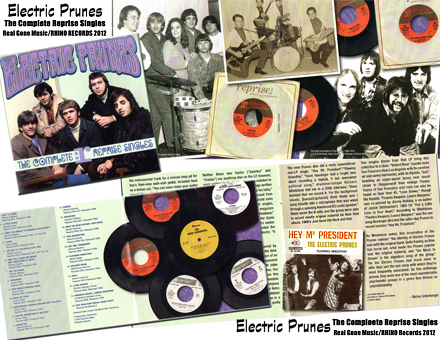
Collage/graphic: R J Whetstone
|
Electric Prunes - 2012
The Complete Reprise Singles
Reissue 2012
on Real Gone Music/RHINO Records
This CD reissue is a beautifully packaged CD containing 24 singles from the Electric Prunes spanning '66-'68. From the original Prunes through the last incarnation, this is a great representation of all single tracks recorded originally for Reprise/Warner Bros. |
*Excerpts from liner notes, written by Richie
Unterberger, for the 2006 CD reissue of the two final
Electric Prunes albums: Just Good Old Rock & Roll and
Release of An Oath, on Collectors Choice Music
Top of Page
|
![]()



 Mark
Kincaid - John Herron - Bob Brandenburg - Richard (Dick) Whetstone
Mark
Kincaid - John Herron - Bob Brandenburg - Richard (Dick) Whetstone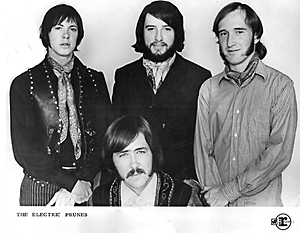


 As
for the range of styles on Just Good 0/d Rock and Roll, Whetstone
remarks, "We were fairly naive in terms of guidance; we had
none, so we were experimenting with a lot of musical styles. If
you listen to the album, you'll hear a lot of diversity, feel and
tempo changes. One reviewer, at the time, said that it was reminiscent
of some of the Yardbirds' tunes. I thought, 'Well, what a nice compliment.'
But it was a little disjointed, and probably lacked a cohesive direction.
We were just throwing everything into the mix. I think once we had
that album completed, we should have started recording another album
with the remaining material we had available. That was our learning
curve." (The exact review quote Whetstone refers to above,
incidentally, was in a June 1969 issue of Boston After Dark, which
declared, "The tunes are driving and reminiscent in their abundant
tempo changes of the old Yardbirds...Every song has been lovingly
polished and yet the hard organ and basic guitar lines leave the
visceral immediacy intact.")
As
for the range of styles on Just Good 0/d Rock and Roll, Whetstone
remarks, "We were fairly naive in terms of guidance; we had
none, so we were experimenting with a lot of musical styles. If
you listen to the album, you'll hear a lot of diversity, feel and
tempo changes. One reviewer, at the time, said that it was reminiscent
of some of the Yardbirds' tunes. I thought, 'Well, what a nice compliment.'
But it was a little disjointed, and probably lacked a cohesive direction.
We were just throwing everything into the mix. I think once we had
that album completed, we should have started recording another album
with the remaining material we had available. That was our learning
curve." (The exact review quote Whetstone refers to above,
incidentally, was in a June 1969 issue of Boston After Dark, which
declared, "The tunes are driving and reminiscent in their abundant
tempo changes of the old Yardbirds...Every song has been lovingly
polished and yet the hard organ and basic guitar lines leave the
visceral immediacy intact.")